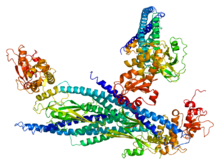STAT5
| signal transducer and activator of transcription 5A | |
|---|---|

STAT5A
|
|
| Identifiers | |
| Symbol | STAT5A |
| Alt. symbols | STAT5 |
| Entrez | 6776 |
| HUGO | 11366 |
| OMIM | 601511 |
| RefSeq | NM_003152 |
| UniProt | P42229 |
| Other data | |
| Locus | Chr. 17 q11.2 |
| signal transducer and activator of transcription 5B | |
|---|---|

STAT5B
|
|
| Identifiers | |
| Symbol | STAT5B |
| Entrez | 6777 |
| HUGO | 11367 |
| OMIM | 604260 |
| RefSeq | NM_012448 |
| UniProt | P51692 |
| Other data | |
| Locus | Chr. 17 q11.2 |
Signal transducer and activator of transcription 5 (STAT5) refers to two highly related proteins, STAT5A and STAT5B, which are part of the seven-membered STAT family of proteins. Though STAT5A and STAT5B are encoded by separate genes, the proteins are 90% identical at the amino acid level. STAT5 proteins are involved in cytosolic signalling and in mediating the expression of specific genes. Aberrant STAT5 activity has been shown to be closely connected to a wide range of human cancers, and silencing this aberrant activity is an area of active research in medicinal chemistry.
In order to be functional, STAT5 proteins must first be activated. This activation is carried out by kinases associated with transmembrane receptors:
In the activation pathway illustrated to the left, the ligand involved is a cytokine and the specific kinase taking part in activation is JAK. The dimerized STAT5 represents the active form of the protein, which is ready for translocation into the nucleus.
Once in the nucleus, the dimers bind to STAT5 response elements, inducing transcription of specific sets of genes. Upregulation of gene expression by STAT5 dimers has been observed for genes dealing with:
Activated STAT5 dimers are, however, short-lived and the dimers are made to undergo rapid deactivation. Deactivation may be carried out by a direct pathway, removing the phosphate groups using phosphatases like PIAS or SHP-2 for example, or by an indirect pathway, which involves reducing cytokine signalling.
...
Wikipedia
